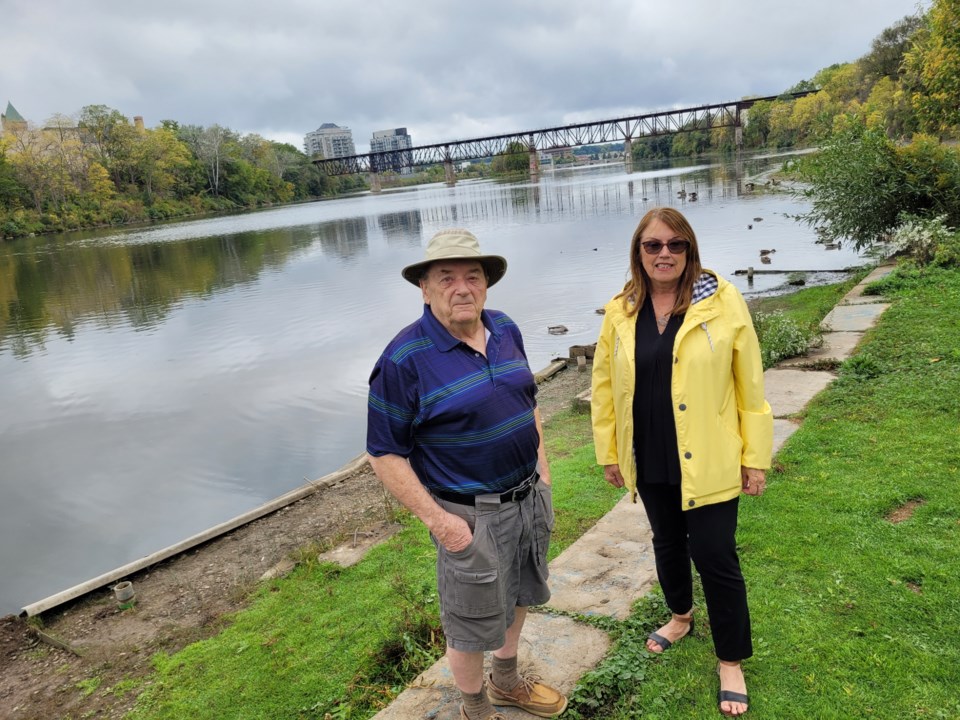Launching a fishing boat with his son and snagging a trout a few feet out from the former dock at Riverbluffs Park is among Bryan Duross's fondest memories.
Fishing along that stretch of river was a regular outing for the family back in the mid '80s and early '90s, when the waterfront park near the CP train bridge was busy with annual summer boat races, picnics and even water skiing.
Duross recalls one outing when he and his wife pulled about 20 smallmouth bass from the section of river near the Galt Country Club.
These days, he says, he doesn't know what kind of fish would bite near the once-abundant fishing holes above the dam.
Silt build up and the toxic heavy metals embedded in it have created mucky shallows and an inhospitable environment for the fish that used to thrive there, Duross says.
And it all stems from when the Park Hill Dam sluice gates were sealed shut in the years following the 1998 deaths of Const. Dave Nicholson and 12-year-old Mark Gage. They died after Gage got trapped in a sluiceway and Nicholson attempted to rescue him.
Sluice gates built into dams below the water line allow silt and other debris to flow freely down the river where it's disbursed naturally and gradually.
Shutting them, prevents silt from moving beyond the dam, and as it builds up, it becomes compacted under a layer of mud.
Before the dam was sealed, the depth of the river above the dam toward Riverbluffs Park was about 15 feet in some spots. Today, silt build up has reduced the depth to a soft layer about eight feet down, just out from the Riverbluffs Dock.
Duross says the heavy silt has rendered bass spawning beds useless and the crayfish population, a major food source for smallmouth bass, has also been destroyed.
Evidence of how extensive the silt build up is began to appear about three years ago when new islands formed just off shore of the park, immediately downstream of the boat ramp and adjacent to the golf course behind Cambridge Memorial Hospital.
Near the dam the silt has become so compacted at the bottom layer that a cutter would be needed to get through it if the Grand River Conservation Authority agrees with Duross that the river needs to be dredged to bring it back to health.
Duross wants to see the GRCA reopen the sluice gates and fence off the dam on either side to prevent anyone from getting near it; a decision he says should have been made in the immediate aftermath of the Park Hill Dam tragedy.
Instead, following a coroner's inquest and public outcry over safety, the GRCA had what Duross calls a "knee jerk" reaction in coming up with a "misguided solution" to close the sluiceways permanently, without much consideration for the impact.
The GRCA's manager of infrastructure Katelyn Lynch says the authority recognizes "the sediment has been increasing over the past several decades and is impacting the navigable waters and sport fisheries in the reach upstream of the Parkhill Dam."
She contends that following the drowning incident and coroner’s inquest the GRCA determined that trade-off was necessary to protect public safety.
The provincial Ministry of the Environment and Fisheries and Oceans Canada have to shoulder part of the blame, Duross says.
They were ineffective in assessing the impact to fish habitat and were "just in such an all fired rush" to do something that bad decisions happened.
He calls a recent letter from the regional director of Fisheries and Oceans Canada "complete garbage" for its assessment that the Park Hill dam is a necessary barrier to protect brook trout populations above the dam from migratory fish species from Lake Erie.
Everyone who made the decision to seal the sluiceways in the dam believe it was the right one for the time says regional councillor and GRCA board member Pam Wolf.
But she agrees with Duross that there's a problem now and has worked to advance his concerns with the conservation authority.
She says common sense may have been overlooked in some of the decisions, but understands public safety always trumps recreation.
Nobody should discount the fact that a boy and police officer drowned, she adds.
Duross disagrees with that notion, saying there were better options on the table to protect public safety, including harsh penalties for anyone caught trespassing.
"This is a pathetic disaster," he says while pointing at the river towards the dam.
Last year, Duross presented his report to board members, prompting a request that staff investigate the situation further.
Budget concerns stalled that work, but Wolf says a report on the silt levels is expected to return to the board table sometime this fall, at which point discussions could begin on what to do next.
Duross says the only solution is dredging to remove the toxic silt, then opening the sluice gates again.
Dredging is essential to prevent what he says would be "an ecological disaster all the way from here to Lake Erie" if the dam was simply opened up or removed.
But the cost is excessive, estimated to be in excess of $10 million for dredging alone.
Removing the dam entirely could be an option too, but as Wolf knows, that would likely be met with fierce opposition.
As a former Cambridge councillor, Wolf is well versed on the impacts of old dams on the watershed. She was one of the few to vote in favour of removing the Riverside dam and naturalizing the Speed River after hearing from Indigenous groups and the GRCA about the harmful impacts it has had on the environment.
She understands better than anyone that people don't like change.
Even though the dam doesn't serve any practical purpose and is likely contributing to degradation of the waterway, many Cambridge residents and beyond would be against it, she says.
